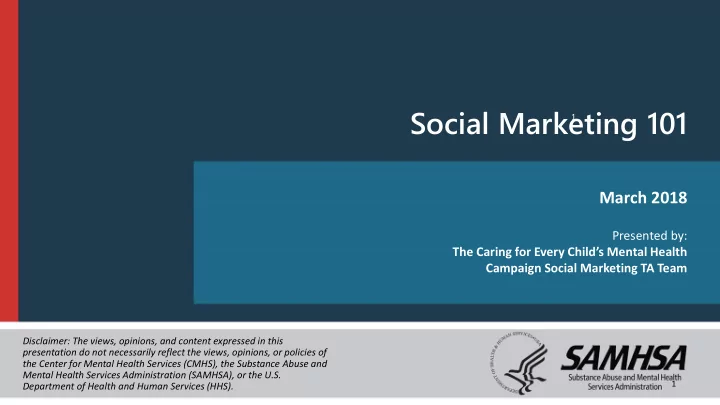

Social Marketing 101 1 March 2018 Presented by: The Caring for Every Child’s Mental Health Campaign Social Marketing TA Team Disclaimer: The views, opinions, and content expressed in this presentation do not necessarily reflect the views, opinions, or policies of the Center for Mental Health Services (CMHS), the Substance Abuse and Mental Health Services Administration (SAMHSA), or the U.S. 1 Department of Health and Human Services (HHS).
Welcome! Kristin Melton Social Marketing Technical Assistance Provider Caring for Every Child’s Mental Health Campaign Vanguard Communications Tim Tunner Social Marketing Technical Assistance Provider Caring for Every Child’s Mental Health Campaign National Association of State Mental Health Program Directors 2
Learning Objectives • Understand ways that social marketing strategies can help achieve the goals of your system of care community. • Become more familiar with the social marketing planning process. • Gain experience in the identification of social marketing goals. • Understand the importance of audience analysis and tailoring messages. 3
What brings you here? 4
What is social marketing? 5 Social marketing is the marketing of behavior change that benefits society as well as the audience. (No, really. That’s it.) 5
A Note on Social Media (Two different things.) 6
Social Marketing: Myth or Fact? 7
The first step in social marketing is to create a brochure... …Myth. Fact: Those who rush to create materials often end up storing hundreds of brochures. 8
You may have heard of … 9
What are you selling? • What is your system of care’s mission? • What issues are most important? • Who is most affected by these issues? 10
How can social marketing help YOU? Increase Number of Change Create Families & Youth Attitudes Buy-In Who Seek Services 11
Social Marketing Committee A social marketing committee is… • A group of individuals within your system of care that represent the different audiences you are trying to reach. “Social marketing should not be about us, without us!” 12
Who needs to be involved? • Evaluators • Families • Youth • Social marketers • Heads of child-serving agencies • Community leaders • Others 13
Who is responsible for social marketing? Everyone! There may be a lead or point person, but social marketing work has to be a collaborative effort among all of those working to sustain your system of care. 14
Benefits of Involving Key Audiences in Social Marketing • Youth and families being involved in social marketing is consistent with family-driven and youth-guided care and practice. • Creates excitement and promotes hope among the community members involved. • Gives the work credibility. • Contributes to the sustainability of systems of care by connecting data to family and youth experiences. • Makes your social marketing efforts more effective. 15
Strategies for Collaboration • Meet early and often. • Support all participants. • Be open to learning about and from each other. • Families and youth can provide additional insight. • Identify youth and family collaboration leaders. • Make sure everyone’s voice is heard. 16
How do you do it? 17
What’s the goal? 18
Formulating Social Marketing Goals Your social marketing goals should help you achieve your program’s goals. Program Goal: Social Marketing Goals: • Enable more people • Raise awareness of services to seek behavioral available. • Reduce negativity associated health services. with seeking services. 19
Who do we need to reach … …and what do we know about them? 20
Audience Each audience that your system of care hopes to reach will have certain barriers and benefits to reaching them. Begin this analysis by asking: • What are the benefits of reaching a particular audience? • What are the barriers that will have to be overcome to reach this audience? 21
Where does your audience stand? Continuum of Understanding and Acceptance Bas asic Desi esire to to learn earn Unaw awareness Inter In terest Full su support unders derstandi ding more 22
Develop messages… …that will resonate with the audience. 23
Create Messages for Specific Audiences Messages should: • Show the importance, urgency, or magnitude of the issue. • Put a “face” on the issue. • Be tied to specific values, beliefs, or interests of the audience. • Be culturally competent. • Be pretested with your audience. 24
Here are some examples… For Families: • Making sure everyone in the family gets help is an important part of helping young adults maintain positive mental health. For Educators: • Academic performance and attendance improve when students are connected to a supportive system of care. For Practitioners: • Positive mental health is essential to a child’s healthy development from birth. Public Safety: • Youth involved with systems of care are less likely to be arrested and have lower recidivism rates. 25
Elevator Speech 26 Can every member of your system of care describe the vision for your system of care? 26
Channels… …are the means through which you will reach your audiences. 27
Activities, Events, and Materials… …are what you will HOST, PRODUCE, OR CREATE to carry your messages to your intended audience. 28
Pretesting… …with your intended audience, and implementation of your plan! 29
Evaluation and Mid- Course Corrections… …ensure that your efforts are effective, and allow you to adjust accordingly. 30
How to stay on task and keep it current: • Remember, social marketing is a continuous process! • First revision (3 to 6 months after the development of the initial plan). • Second revision (6 to 12 months after the first revision of the plan). • We are available to meet with you! 31
QUESTIONS? 32
Thank you for participating! Please take a moment to fill out a Tim Tunner feedback form. Timothy.Tunner@nasmhpd.org 703 – 682 – 5197 Kristin Melton Thank you! kmelton@vancomm.com 618 – 841 – 4069 33
Recommend
More recommend